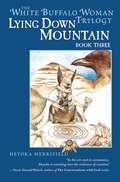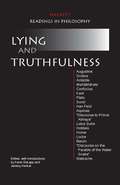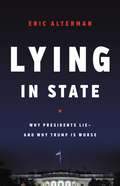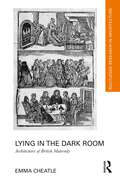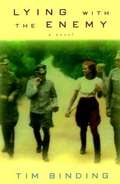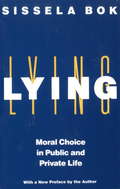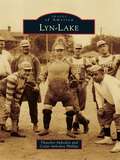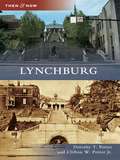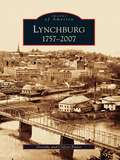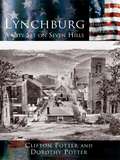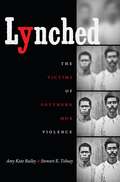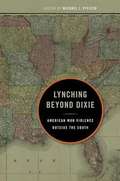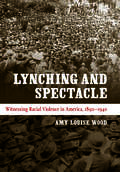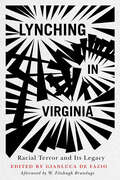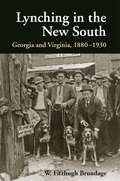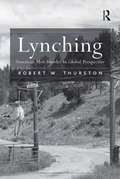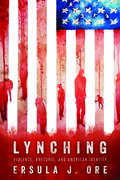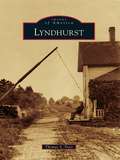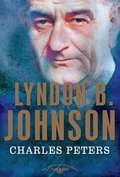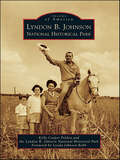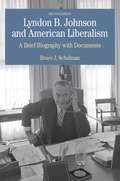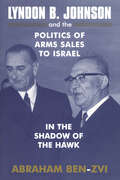- Table View
- List View
Lying Down Mountain
by Heyoka MerrifieldIn this third volume of the White Buffalo Woman Trilogy, Heyoka Merrifield continues the story of White Buffalo Woman and her journey through the land of the Lying Down Mountain. Set in the home of the peaceful Hopi Nation and based on Hopi culture and mythology, Lying Down Mountain contains sacred wisdom of peace and spirituality that can bring tranquility to today's turbulent Mother Earth. The Native American saga begins with the first two volumes in the series, Eyes of Wisdom and Painted Earth Temple.
Lying and Truthfulness
by Kevin Delapp Jeremy HenkelThis anthology provides a set of distinctive selections that explore both Western and Eastern views of lying and truthfulness, including selections from Augustine, Grotius, Aristotle, the Mahābhārata, Confucius, Kant, Plato, Sunzi, Han Feizi, Aquinas, the Lotus Sutra, Hobbes, Hume, Locke, Bacon, Nietzsche, and more. Hackett Readings in Philosophy is a versatile series of compact anthologies, each devoted to a topic of traditional interest in philosophy or political theory. Selections are chosen for their accessibility, significance, and ability to stimulate thought and discussion.
Lying in State: Why Presidents Lie -- And Why Trump Is Worse
by Eric AltermanThis definitive history of presidential lying reveals how our standards for truthfulness have eroded -- and why Trump's lies are especially dangerous.If there's one thing we know about Donald Trump, it's that he lies. But he's by no means the first president to do so. In Lying in State, Eric Alterman asks how we ended up with such a pathologically dishonest commander in chief, showing that, from early on, the United States has persistently expanded its power and hegemony on the basis of presidential lies. He also reveals the cumulative effect of this deception-each lie a president tells makes it more acceptable for subsequent presidents to lie-and the media's complicity in spreading misinformation. Donald Trump, then, represents not an aberration but the culmination of an age-old trend. Full of vivid historical examples and trenchant analysis, Lying in State is essential reading for anyone seeking to understand how we arrived in this age of alternative facts.
Lying in the Dark Room: Architectures of British Maternity (Routledge Research in Architecture)
by Emma CheatleLying in the Dark Room: Architectures of British Maternity returns to and reflects on the spatial and architectural experience of childbirth, through both a critical history of maternity spaces and a creative exploration of those we use today. Where conventional architectural histories objectify buildings (in parallel with the objectification of the maternal body), the book—in the mode of creative practice research—presents a creative-critical autotheory of the architecture of lying-in. It uses feminist, subjective modes of thinking that travel across disciplines, registers and arguments. The book assesses the transformation of maternity spaces—from the female bedchamber of seventeenth- and eighteenth-century marital homes, to the lying-in hospitals of the eighteenth and nineteenth centuries purposely built by man-midwives, to the late twentieth-century spaces of home and the modern hospital maternity wing—and the parallel shifts in maternal practices. The spaces are not treated as mute or neutral backdrops to maternal history but as a series of vital, entangled atmospheres, materials, practices and objects that are produced by, and, in turn, produce particular social and political conditions, gendered structures and experiences. Moving across spaces, systems, protagonists and their subjectivities, the book shows how hospital design and protocol altered ordinary birth at home and continues to shape maternal spatial experience today. As such, it will be of interest to a wide range of readers, from architectural historians, theoreticians, designers and students to medical humanities historians, to English Literature, humanities and material studies scholars, as well as those interested in creative-critical writing.
Lying with the Enemy
by Tim BindingIn 1943, 145,000 Germans had been slaughtered in Stalingrad. The tide of the war was beginning to turn. But not on the quiet, idyllic island of Guernsey, the only British territory to be occupied by German troops in the Second World War. Here Nazi officers still party with local girls, love affairs blossom, and the amateur dramatic society continues to stage its theatricals, if with suspiciously jackbooted pirates in Peter Pan. Then the body of a young woman, her nose and mouth filled with cement, turns up, and the comedy of manners played out by the collaborators and their captors turns sour. Food becomes scarce, facades of civility crack, the skies over Guernsey darken, and the search for a killer unearths horrors shared by the islanders and the enemy alike.
Lying: Moral Choice in Public and Private Life
by Sissela BokA thoughtful addition to the growing debate over public and private morality. Looks at lying and deception in law, family, medicine, government.
Lyle Creelman
by Susan E. Armstrong-ReidThis intriguing scholarly biography examines the important contributions of Canada's foremost international nurse, Lyle Creelman. Creelman parlayed her experience as a community health nurse in British Columbia into significant international appointments with two organizations undertaking massive responsibility for health tasks in the post-war period - first, as chief nurse of the British Zone of Occupied Germany with the United Nations Relief and Rehabilitation Administration (UNRRA), and, from 1954 to 1968, the Chief Nursing Officer of the World Health Organization (WHO).In telling Creelman's fascinating story, Susan Armstrong-Reid helps readers learn about the transformation of the nursing profession and global health governance in the twentieth century. This story challenges the prevailing portrait of expatriate nurses during this period as agents of Western cultural imperialism. Lyle Creelman: The Frontiers of Global Nursing not only recasts the broader historical narrative of nursing's legacy to global health, but contextualizes its continuing importance for approaching health care in the twenty-first-century.
Lyn-Lake (Images of America)
by Thatcher Imboden Cedar Imboden PhillipsThe Lyn-Lake area of Minneapolis, centered around the intersection of Lyndale Avenue and West Lake Street, is one of the city's most distinctive neighborhoods. The core commercial district is one of the oldest in South Minneapolis, thanks in part to its strategic location along several early streetcar lines. A rail line along Twenty-ninth Street, now the Midtown Greenway, brought an industrial element to the neighborhood and provided additional jobs for the thousands of residents who lived in the surrounding houses and apartment buildings. As the neighborhood evolved, it took on a distinctive bohemian bent and filled with a diverse mix of artists, musicians, and writers living side by side with blue-collar industrial workers, along with those who worked at professional office jobs downtown. Lyn-Lake retains its unique flavor today, characterized by its blend of both the historical and the cutting edge.
Lynchburg
by Clifton W. Potter Jr. Dorothy T. PotterSince its beginning as a ferry crossing in 1757, the city of Lynchburg has covered the hills that rise above the James River. A community that has managed to successfully blend its past with the best that the present has to offer, Lynchburg is truly the "Heart of Virginia." Holding doctorates in history, authors Dorothy T. and Clifton W. Potter Jr. have spent their professional careers teaching at Lynchburg College.
Lynchburg: 1757-2007 (Images of America)
by Dorothy Potter Clifton PotterIn the spring of 1757, the Lynch brothers established a ferry across the James River to transport settlers on their way to the Ohio Valley. Within a decade, the settlement clustered around the ferry house became known as Lynchburg. For a century, the city was regarded as one of the most important transportation centers in the Upper South, although its real fortune lay in tobacco. After the Civil War, Lynchburg evolved into a manufacturing center with a broadly based economy. As it marks its 250th anniversary, Lynchburg has become a focus for higher education and tourism in Central Virginia. From the development of the modern camera to the current digital revolution, this photographic record of Lynchburg and the surrounding counties' growth is rich, varied, and traces their transformation almost from their birth to the present day.
Lynchburg: A City Set on Seven Hills
by Dorothy Potter Clifton PotterOnce the primary hunting ground of the Monocan Indians and later a harmonious common area shared with the Quakers, Lynchburg was a crossroads for various cultures even before its founding following the French and Indian War. With roots in the prosperous tobacco fields, the City of Seven Hills became one of the nation's wealthiest communities by the Civil War. During the robust and arduous times to come, Lynchburg continued to thrive by developing diverse industries and eventually becoming a respected educational center.
Lynched
by Amy Kate Bailey Stewart E. TolnayOn July 9, 1883, twenty men stormed the jail in Morehouse Parish, Louisiana, kidnapped Henderson Lee, a black man charged with larceny, and hanged him. Events like this occurred thousands of times across the American South in the late nineteenth and early twentieth centuries, yet we know scarcely more about any of these other victims than we do about Henderson Lee. Drawing on new sources to provide the most comprehensive portrait of the men and women lynched in the American South, Amy Bailey and Stewart Tolnay's revealing profiles and careful analysis begin to restore the identities of--and lend dignity to--hundreds of lynching victims about whom we have known little more than their names and alleged offenses.Comparing victims' characteristics to those of African American men who were not lynched, Bailey and Tolnay identify the factors that made them more vulnerable to being targeted by mobs, including how old they were; what work they did; their marital status, place of birth, and literacy; and whether they lived in the margins of their communities or possessed higher social status. Assessing these factors in the context of current scholarship on mob violence and reports on the little-studied women and white men who were murdered in similar circumstances, this monumental work brings unprecedented clarity to our understanding of lynching and its victims.
Lynching Beyond Dixie: American Mob Violence Outside the South
by Michael J. PfeiferIn recent decades, scholars have explored much of the history of mob violence in the American South, especially in the years after Reconstruction. However, the lynching violence that occurred in American regions outside the South, where hundreds of persons, including Hispanics, whites, African Americans, Native Americans, and Asian Americans died at the hands of lynch mobs, has received less attention. This collection of essays by prominent and rising scholars fills this gap by illuminating the factors that distinguished lynching in the West, the Midwest, and the Mid-Atlantic. The volume adds to a more comprehensive history of American lynching and will be of interest to all readers interested in the history of violence across the varied regions of the United States. Contributors are Jack S. Blocker Jr., Brent M. S. Campney, William D. Carrigan, Sundiata Keita Cha-Jua, Dennis B. Downey, Larry R. Gerlach, Kimberley Mangun, Helen McLure, Michael J. Pfeifer, Christopher Waldrep, Clive Webb, and Dena Lynn Winslow.
Lynching Reconsidered: New Perspectives in the Study of Mob Violence
by William D. CarriganThe history of lynching and mob violence has become a subject of considerable scholarly and public interest in recent years. Popular works by James Allen, Philip Dray, and Leon Litwack have stimulated new interest in the subject. A generation of new scholars, sparked by these works and earlier monographs, are in the process of both enriching and challenging the traditional narrative of lynching in the United States. This volume contains essays by ten scholars at the forefront of the movement to broaden and deepen our understanding of mob violence in the United States. These essays range from the Reconstruction to World War Two, analyze lynching in multiple regions of the United States, and employ a wide range of methodological approaches. The authors explore neglected topics such as: lynching in the Mid-Atlantic, lynching in Wisconsin, lynching photography, mob violence against southern white women, black lynch mobs, grassroots resistance to racial violence by African Americans, nineteenth century white southerners who opposed lynching, and the creation of 'lynching narratives' by southern white newspapers. This book was first published as a special issue of American Nineteenth Century History
Lynching and Spectacle: Witnessing Racial Violence in America, 1890-1940
by Amy Louise WoodLynch mobs in late nineteenth- and early twentieth-century America exacted horrifying public torture and mutilation on their victims. InLynching and Spectacle, Amy Wood explains what it meant for white Americans to perform and witness these sadistic spectacles and how lynching played a role in establishing and affirming white supremacy. Lynching, Wood argues, overlapped with a variety of cultural practices and performances, both traditional and modern, including public executions, religious rituals, photography, and cinema, all which encouraged the horrific violence and gave it social acceptability. However, she also shows how the national dissemination of lynching images ultimately fueled the momentum of the antilynching movement and the decline of the practice. Using a wide range of sources, including photos, newspaper reports, pro- and antilynching pamphlets, early films, and local city and church records, Wood reconfigures our understanding of lynching's relationship to modern life. Wood expounds on the critical role lynching spectacles played in establishing and affirming white supremacy at the turn of the century, particularly in towns and cities experiencing great social instability and change. She also shows how the national dissemination of lynching images fueled the momentum of the antilynching movement and ultimately led to the decline of lynching. By examining lynching spectacles alongside both traditional and modern practices and within both local and national contexts, Wood reconfigures our understanding of lynching's relationship to modern life.
Lynching in America
by Christopher WaldrepWhether conveyed through newspapers, photographs, or Billie Holliday's haunting song "Strange Fruit," lynching has immediate and graphic connotations for all who hear the word. Images of lynching are generally unambiguous: black victims hanging from trees, often surrounded by gawking white mobs. While this picture of lynching tells a distressingly familiar story about mob violence in America, it is not the full story. Lynching in America presents the most comprehensive portrait of lynching to date, demonstrating that while lynching has always been present in American society, it has been anything but one-dimensional.Ranging from personal correspondence to courtroom transcripts to journalistic accounts, Christopher Waldrep has extensively mined an enormous quantity of documents about lynching, which he arranges chronologically with concise introductions. He reveals that lynching has been part of American history since the Revolution, but its victims, perpetrators, causes, and environments have changed over time. From the American Revolution to the expansion of the western frontier, Waldrep shows how communities defended lynching as a way to maintain law and order. Slavery, the Civil War, and especially Reconstruction marked the ascendancy of racialized lynching in the nineteenth century, which has continued to the present day, with the murder of James Byrd in Jasper, Texas, and Supreme Court Justice Clarence Thomas's contention that he was lynched by Congress at his confirmation hearings.Since its founding, lynching has permeated American social, political, and cultural life, and no other book documents American lynching with historical texts offering firsthand accounts of lynchings, explanations, excuses, and criticism.
Lynching in Virginia: Racial Terror and Its Legacy (The American South Series)
by W. Fitzhugh BrundageUncovering the history and examining the legacy of lynching in the state of Virginia Although not as associated with lynching as other southern states, Virginia has a tragically extensive history with these horrific crimes. This important volume examines the more than one hundred people who were lynched in Virginia between 1866 and 1932. Its diverse set of contributors—including scholars, journalists, activists, and students—recover this wider history of lynching in Virginia, interrogate its legacy, and spotlight contemporary efforts to commemorate the victims of racial terror across the commonwealth. Together, their essays represent a small part of the growing effort to come to terms with the role Virginia played in perpetuating America&’s national shame.
Lynching in the New South: Georgia and Virginia, 1880-1930 (Blacks in the New World)
by W. Fitzhugh BrundageLynching was a national crime. But it obsessed the South. W. Fitzhugh Brundage's multidisciplinary approach to the complex nature of lynching delves into the such extrajudicial murders in two states: Virginia, the southern state with the fewest lynchings; and Georgia, where 460 lynchings made the state a measure of race relations in the Deep South. Brundage's analysis addresses three central questions: How can we explain variations in lynching over regions and time periods? To what extent was lynching a social ritual that affirmed traditional white values and white supremacy? And, what were the causes of the decline of lynching at the end of the 1920s? A groundbreaking study, Lynching in the New South is a classic portrait of the tradition of violence that poisoned American life.
Lynching: American Mob Murder in Global Perspective
by Robert W. ThurstonAddressing one of the most controversial and emotive issues of American history, this book presents a thorough reexamination of the background, dynamics, and decline of American lynching. It argues that collective homicide in the US can only be partly understood through a discussion of the unsettled southern political situation after 1865, but must also be seen in the context of a global conversation about changing cultural meanings of 'race'. A deeper comprehension of the course of mob murder and the dynamics that drove it emerges through comparing the situation in the US with violence that was and still is happening around the world. Drawing on a variety of approaches - historical, anthropological and literary - the study shows how concepts of imperialism, gender, sexuality, and civilization profoundly affected the course of mob murder in the US. Lynching provides thought-provoking analyses of cases where race was - and was not - a factor. The book is constructed as a series of case studies grouped into three thematic sections. Part I, Understanding Lynching, starts with accounts of mob murder around the world. Part II, Lynching and Cultural Change, examines shifting concepts of race, gender, and sexuality by drawing first on the romantic travel and adventure fiction of the era 1880-1920, from authors such as H. Rider Haggard and Edgar Rice Burroughs. Changing images of black and white bodies form another major focus of this section. Part III, Blood, Debate, and Redemption in Georgia, follows the story of American collective murder and growing opposition to it in Georgia, a key site of lynching, in the early twentieth century. By situating American mob murder in a wide international context, and viewing the phenomenon as more than simply a tool of racial control, this book presents a reappraisal of one of the most unpleasant, yet important periods of America's history, one that remains crucial for understanding race relations and collective violence around the world.
Lynching: Violence, Rhetoric, and American Identity (Race, Rhetoric, and Media Series)
by Ersula J. OreWinner of the 2020 Rhetoric Society of America Book AwardWhile victims of antebellum lynchings were typically white men, postbellum lynchings became more frequent and more intense, with the victims more often black. After Reconstruction, lynchings exhibited and embodied links between violent collective action, American civic identity, and the making of the nation.Ersula J. Ore investigates lynching as a racialized practice of civic engagement, in effect an argument against black inclusion within the changing nation. Ore scrutinizes the civic roots of lynching, the relationship between lynching and white constitutionalism, and contemporary manifestations of lynching discourse and logic today. From the 1880s onward, lynchings, she finds, manifested a violent form of symbolic action that called a national public into existence, denoted citizenship, and upheld political community.Grounded in Ida B. Wells’s summation of lynching as a social contract among whites to maintain a racial order, at its core, Ore’s book speaks to racialized violence as a mode of civic engagement. Since violence enacts an argument about citizenship, Ore construes lynching and its expressions as part and parcel of America’s rhetorical tradition and political legacy.Drawing upon newspapers, official records, and memoirs, as well as critical race theory, Ore outlines the connections between what was said and written, the material practices of lynching in the past, and the forms these rhetorics and practices assume now. In doing so, she demonstrates how lynching functioned as a strategy interwoven with the formation of America’s national identity and with the nation’s need to continually restrict and redefine that identity. In addition, Ore ties black resistance to lynching, the acclaimed exhibit Without Sanctuary, recent police brutality, effigies of Barack Obama, and the killing of Trayvon Martin.
Lyndhurst
by Thomas S. TreerMoses Cleaveland was sent to survey the lands of the Western Reserve of Connecticut into townships in 1796. Due to a strike, the surveyors were given plots within the new Euclid Township as part of their compensation. They sold these plots to arriving settlers from the east. Aristarkus and Sarah Brainard, the area's first family, arrived in 1831. In 1877, the Mayfield Plank Road was constructed allowing a steady stream of people and goods to easily travel from eastern farms to markets found at Doan's Corners in Cleveland, Ohio. As this part of Euclid Township grew, the area became Euclidville Village, later changed to Lyndhurst Village in 1920. The post-World War II building boom brought many young families to Lyndhurst and transformed the sleepy village into a charming 21st-century suburb.
Lyndon B. Johnson (The American Presidents Series)
by Arthur M. Schlesinger Charles PetersPeters, a keen observer of Washington politics for more than five decades, shares his insider knowledge and experiences to tell the story of Johnson's presidency as the tale of an immensely talented politician driven by ambition and desire.
Lyndon B. Johnson National Historical Park
by Kelly Carper Polden Lyndon B. Johnson National Historical Park Lynda Johnson RobbPres. Lyndon B. Johnson took pride in his heritage and in the Texas Hill Country roots of his pioneer ancestors. He delighted in showing guests the ancestral settlement, and his birthplace, boyhood home, and the family treasure: the LBJ Ranch and the home that became known as the Texas White House. LBJ generously gifted these cherished assets to the people of the United States. Lyndon B. Johnson National Historical Park holds more assets significant to an American president than any other U.S. presidential site. Visitors may stroll through the Johnson Settlement, stepping back in time to the 1860s, when President Johnson�s ancestors helped settle Johnson City, which was named after James Polk Johnson, nephew to LBJ�s grandfather. The Boyhood Home and Visitor Center are located close to the Johnson Settlement, and visitors can tour the reconstructed Birthplace and enjoy a scenic drive through the LBJ Ranch before touring the Texas White House. This book illustrates the significance of LBJ�s heritage and the circle of life represented by what is both a birthplace and a final resting place.
Lyndon B. Johnson and American Liberalism: A Brief Biography With Documents (Bedford Series in History and Culture )
by Bruce J. SchulmanWhether admired or reviled, Lyndon B. Johnson and his tumultuous administration embodied the principles and contradictions of his era. Taking advantage of newly released evidence, this second edition incorporates a selection of fresh documents, including transcripts of Johnson's phone conversations and conservative reactions to his leadership, to examine the issues and controversies that grew out of Johnson's presidency and have renewed importance today. The voices of Johnson, his aides, his opponents, and his interpreters address the topics of affirmative action, the United States' role in world affairs, civil rights, Vietnam, the Great Society, and the fate of liberal reform. Additional photographs of Johnson in action complement Bruce J. Schulman's rich biographical narrative, and a chronology, an updated bibliographical essay, and new questions for consideration provide pedagogical support.
Lyndon B. Johnson and the Politics of Arms Sales to Israel: In the Shadow of the Hawk (Israeli History, Politics And Society Ser.)
by Abraham Ben-ZviLyndon B. Johnson and the Politics of Arms Sales to Israel seeks to reconstruct and elucidate the processes behind the decisions made by the Johnson Administration during the years 1965-68 to sell Israel M-48 tanks, A-4 Skyhawk planes and F-4 Phantom planes. This examination is based on a distinction between three factions which competed for influe
